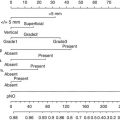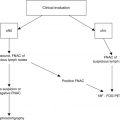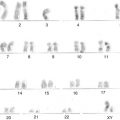Clinical classification
T
Primary tumor
TX
Primary tumor cannot be assessed
T0
No evidence of primary tumor
Tis
Carcinoma in situ
Ta
Noninvasive verrucous carcinoma, not associated with destructive invasion
T1
Tumor invades subepithelial connective tissue
T1a
Tumor invades subepithelial connective tissue without lymphovascular invasion and is not poorly differentiated or undifferentiated (T1G1–2)
T1b
Tumor invades subepithelial connective tissue with lymphovascular invasion or is poorly differentiated or undifferentiated (T1G3–4)
T2
Tumor invades corpus spongiosum/corpora cavernosa
T3
Tumor invades urethra
T4
Tumor invades adjacent structures
N
Regional lymph nodes
NX
Regional lymph nodes cannot be assessed
N0
No palpable or visibly enlarged inguinal lymph node
N1
Palpable mobile unilateral inguinal lymph node
N2
Palpable mobile multiple or bilateral inguinal lymph nodes
N3
Fixed inguinal nodal mass or pelvic lymphadenopathy, unilateral or bilateral
M
Distant metastasis
M0
No distant metastasis
M1
Distant metastasis
Pathological classification
The pT categories correspond to the T categories. The pN categories are based upon biopsy or surgical excision
pN
Regional lymph nodes
pNx
Regional lymph nodes cannot be assessed
pN0
No regional lymph nodes metastasis
pN1
Intranodal metastasis
pN2
Metastasis in multiple or bilateral inguinal lymph nodes
pN3
Metastasis in pelvic lymph node(s), unilateral or bilateral or extranodal extension of regional lymph node metastasis
pM
Distant metastasis
pM0
No distant metastasis
pM1
Distant metastasis
G
Histopathological grading
Gx
Grade of differentiation cannot be assessed
G1
Well differentiated
G2
Moderately differentiated
G3–4
Poorly differentiated or undifferentiated
Until 2008, all histopathology was revised by a single experienced uropathologist. Since then, all histopathological examinations were not revised but reported by experienced uropathologists. Grade was assigned as well, moderately or poorly differentiated based on the amount of undifferentiated cells within the tumor on histopathological examination according to Broders [23]. Lymphovascular invasion was defined as the presence of embolic tumor cells in thin-walled vessel-like structures using routinely stained sections. Finally, extranodal extension (ENE) was defined as extension of tumor through the lymph node capsule into the perinodal fibrous adipose tissue.
Patient Follow-Up
Since 1988, the follow-up has been standardized at our institute. This involves physical examination of the penis and groins at the outpatient clinic every 2 months during the first 2 years, at 3-month intervals in the third year, and 6-month intervals thereafter. Imaging with ultrasound and CT was done on indication. Patients were discharged from follow-up after 10 years without evidence of disease. The follow-up scheme was altered after analysis of recurrence patterns and consists now of a more risk-adapted follow-up scheme [24].
Management of Penile Cancer Over Time
We divided patients into four cohorts according to the introduction of changes in treatment.
Cohort 1: 1956–1987
The first cohort consisted of patients documented from 1956. Until 1988, a wait-and-see policy was applied to patients presenting with cN0 groins. Patients who first presented with clinically node-positive patients (cN+) or patients who developed clinical apparent metastatic disease during follow-up underwent an ipsilateral iLND.
Cohort 2: 1988–1993
In 1988, standardized management and follow-up was introduced based on an analysis of treatment results [14, 22, 25, 26]. Also a risk-adapted approach was a standard of care in patients presenting with cN0 groins. In general, elective bilateral iLND was introduced for cN0 patients considered to be at high risk (≥T2G3) for lymphatic invasion. The second cohort consisted of patients diagnosed between January 1988 and January 1994.
Cohort 3: 1994–2000
In 1994, DSNB was introduced for patients presenting with cN0 groins. Patients diagnosed between January 1994 and December 2000 were included in the third cohort.
Cohort 4: 2001–2012
In 2001, several modifications were applied to the DSNB procedure as described earlier [27], thereby increasing its sensitivity [5]. Since 2004, DSNB is also performed for all patients with ≥T1b tumors.
Furthermore, glans resection and resurfacing became more standardized in selected patients. Therefore, the fourth cohort consisted of patients diagnosed with SCCp after 2001.
Patient Characteristics
The median observed follow-up duration of the 944 patients was 64 months. The four cohorts consisted of 97, 55, 164, and 628 patients, respectively. Table 9.2 shows patient characteristics at presentation. No significant age differences were found between the cohorts (p value = 0.3427). During the study period, significantly more patients appeared to have poorer differentiated tumors (G3) (p value = 0.0373).
Table 9.2
Patient characteristics
Cohort 1 1956–1987 | Cohort 2 1988–1993 | Cohort 3 1994–2000 | Cohort 4 2001–2012 | Total | |
|---|---|---|---|---|---|
Number of patients | 97 | 55 | 164 | 628 | 944 |
Median follow-up (months) | 135 (2–399) | 161 (2–268) | 107 (5–207) | 49 (1–127) | 64 (1–399) |
Median age at diagnosis (range) | 65 (30–94) | 62 (36–89) | 62 (21–92) | 65 (23–96) | 64 (21–96) |
pT stage | |||||
pTis | 1 (1 %) | 9 (16 %) | 13 (8 %) | 47 (7 %) | 70 (7 %) |
pTa | 0 (0 %) | 0 (0 %) | 1 (1 %) | 3 (0 %) | 4 (0 %) |
pT1a | 30 (31 %) | 17 (31 %) | 39 (24 %) | 161 (26 %) | 247 (26 %) |
pT1b | 14 (14 %) | 4 (4 %) | 12 (7 %) | 45 (7 %) | 75 (8 %) |
pT2 | 47 (48 %) | 25 (45 %) | 89 (54 %) | 319 (51 %) | 480 (51 %) |
pT3 | 4 (4 %) | 0 (0 %) | 7 (4 %) | 46 (7 %) | 57 (6 %) |
pT4 | 1 (1 %) | 0 (0 %) | 3 (2 %) | 7 (1 %) | 11 (1 %) |
Grade of differentiation | |||||
CIS | 1 (1 %) | 9 (16 %) | 13 (8 %) | 47 (7 %) | 70 (7 %) |
G1 – well | 41 (42 %) | 22 (40 %) | 54 (33 %) | 188 (30 %) | 305 (32 %) |
G2 – intermediate | 43 (45 %) | 19 (35 %) | 69 (42 %) | 248 (39 %) | 379 (40 %) |
G3 – poor | 10 (10 %) | 5 (9 %) | 27 (17 %) | 123 (20 %) | 165 (17 %) |
Missing | 2 (2 %) | 0 (0 %) | 1 (0 %) | 22 (4 %) | 25 (4 %) |
Kind of penile surgery a | |||||
pT1–2 | |||||
Penis preservingb | 39 (41 %) | 19 (41 %) | 86 (60 %) | 297 (52 %) | 441 (51 %) |
(Partial) amputation | 52 (54 %) | 27 (59 %) | 51 (35 %) | 226 (39 %) | 356 (42 %) |
pT3–4 | |||||
Penis preserving | 1 (1 %) | 0 (0 %) | 1 (1 %) | 8 (1 %) | 10 (1 %) |
(Partial) amputation | 4 (4 %) | 0(0 %) | 6 (4 %) | 42 (7 %) | 52 (6 %) |
cN stage | |||||
cN0 | 60 (62 %) | 47 (85 %) | 140 (85 %) | 489 (78 %) | 736 (78 %) |
cN+ | 37 (38 %) | 8 (15 %) | 24 (15 %) | 139 (22 %) | 208 (22 %) |
cN1 | 18 | 5 | 11 | 78 | 112 |
cN2 | 15 | 3 | 10 | 27 | 55 |
cN3
Stay updated, free articles. Join our Telegram channel
Full access? Get Clinical Tree
 Get Clinical Tree app for offline access
Get Clinical Tree app for offline access

| |||||




